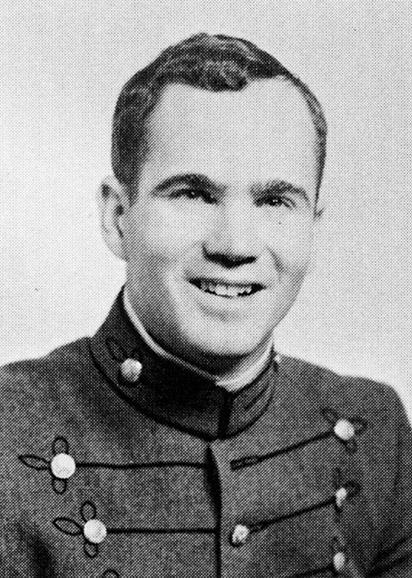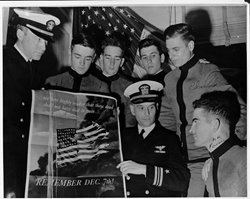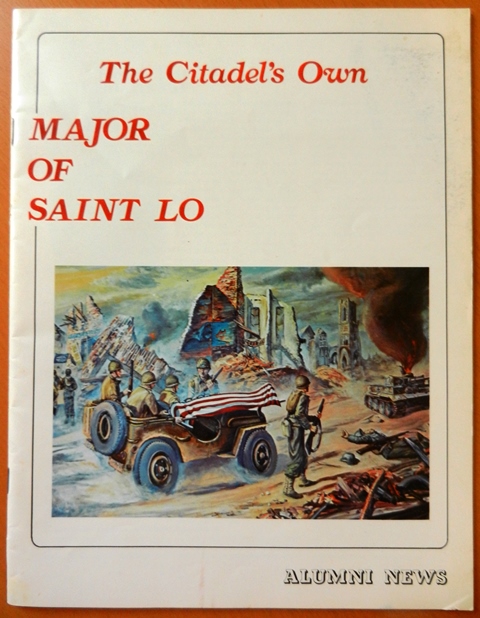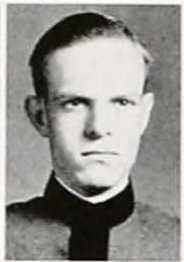Charles Alister Witsell, Jr., Class of 1946
Born on April 21, 1924, in Colleton County, South Carolina, to Pauline and Charles Witsell, Charles, Jr., grew up on Hampton Street in Walterboro. His father was a 1921 graduate of The Citadel. He attended the public schools of Walterboro. After graduating from Walterboro High School in 1941, he attended the Porter Military Academy for one year before entering The Citadel at the beginning of the 1942-43 academic year with the Class of 1946. He was a Cadet Private Fourth Class in Company M of the South Carolina Corps of Cadets.

Charles enlisted in the service on July 30, 1943 at Fort Jackson. Originally volunteering for (more…)
LIFE AT THE CITADEL
Chicago Tribune, Chicago, Illinois, Sunday, May 31, 1942, p.43
This is another in a series of articles on Life on the Campus at our leading schools and colleges. By ELEANOR NANGLE
FOR THE last week more than 200 first classmen at the Citadel, the Military College of South Carolina at Charleston, have been approaching, with a reluctance they wouldn’t have believed possible four years ago, the most eagerly anticipated event of their lives. As seniors they have led the corps for the last time. They have formed in the reviewing stand to receive the last parade. Yesterday they were graduated.
Today they are scattering to their homes in all parts of the country, most of them pausing only briefly before they enter the armed services. But something of them remains at the Citadel, adding in large or small measure to the vast stores of cadet tales and traditions there. And the spirit of the Citadel goes with them. In the life of all Citadel men the thread of Citadel memories is one of the most colorful, durable, and treasured in its whole tapestry.
Full-dress parade in the Spring of 1943 (Courtesy of The Citadel Archives)
The Citadel man has absorbed more than rigorous training of mind, body, and spirit, and when he reviews them, as all graduating cadets do on commencement day, he places new value on other gifts of the school to the student – the Spartan discipline, the good counsel, the friendships, the democracy, the pageantry of patriotism and the essence of it. (more…)
Perry Moses Phelps, ’29
Perry M. Phelps was born in North Carolina to Rosalie Virginia Moses and Aaron Cohen Phelps on April 22, 1909. He was a member of the Class of 1929, graduating from The Citadel in Charleston, SC, with a Bachelors degree in Business Administration. He was a member of Cadet Company “E” when this photograph was made for the 1928 Sphinx, the yearbook of the South Carolina Corps of Cadets.
 Cadet Private Perry Moses Phelps, Class of 1929
Cadet Private Perry Moses Phelps, Class of 1929
Following graduation from The Citadel, Perry Phelps became a well-known citizen of Sumter, South Carolina where he was associated with (more…)
Army ROTC at The Citadel celebrates 100 years
Citadel Coastal Artillery Corps ROTC cadets with 8 inch Howitzer M1918 MkVIII, circa 1923
Originally published by The Citadel, October 20, 2016, on thedigitel.com
The Citadel marks its Army ROTC Centennial on Oct. 21, 2016
By Maj. Steve Smith, TAC officer and Citadel historian
The Citadel applied to the U.S. Department of War in 1882, requesting that an Army officer be assigned to the college as Professor of Military Science and Tactics. That application laid the groundwork for what would eventually become an Army ROTC program at the college. (Photo: Citadel CAC ROTC cadets drilling Howitzer M1918 MkVIII, circa 1923)
In the coming years, The Citadel was classified as an Essentially Military College — meaning students were housed in barracks, constantly in uniform, and bound to a disciplinary system. As a result, the war department’s college division inspected The Citadel annually from 1904-27, during which time the college earned the distinguished college title 20 times until the program was suspended. In 1916 and 1917, the designation allowed The Citadel to recommend (more…)
Pat Conroy, the Lowcountry’s Prince of Tides, passes away
Excerpts from the like titled article written by Brian Hicks and published by Post & Courier, Charleston, South Carolina, March 4, 2016. FULL ORIGINAL ARTICLE HERE
Pat Conroy, the best-selling novelist and proud adoptive son of the Lowcountry who wrote lyrically about Charleston and unflinchingly about The Citadel, died Friday. He was 70.
 Cadet Pat Conroy, Class of 1967
Cadet Pat Conroy, Class of 1967
Source: The Citadel Athletics
The author of “The Great Santini,” “The Lords of Discipline” and “The Prince of Tides” and eight other books passed away shortly after being diagnosed with an aggressive form of cancer that had gone undetected. He died at 7:43 p.m., surrounded by loved ones and family.
The Citadel mourned his passing Friday night.
“This is a very sad day for The Citadel family. Pat Conroy was a world-renowned author, active in his community and a passionate alumnus of The Citadel. He will be missed,” Lt. Gen. John Rosa, Citadel President said.
He wore The Ring (more…)
Thomas Hutson Martin, Jr., Class of 1940
This biography was written by a West Point classmate (Class of 1943) and published on the website of the West Point Association of Graduates. View the Original. In this post, photos of Cadet Martin from the 1939 Sphinx, the yearbook of the South Carolina Corps of Cadets, are included.
Thomas Hutson Martin, Jr. was that unusual combination of talents: soldier, engineer, leader, and musician. His father, a Fellow of the American College of Surgeons, was a native of South Carolina, as was his mother whose Scotch name of Mclnnes showed their affiliation to the Scotch Presbyterian Church. His preparation for West Point included the Charleston High School in Charleston, South Carolina, and three years at The Citadel where he rose to the rank of cadet lieutenant. With that background, it was a foregone conclusion that Hut would rise, as he did, to Second Class corporal, First Class lieutenant and Company Commander of C Company, 2d Regiment. These soldierly virtues combined with a class rank under one hundred to give Hut the berth as a Lieutenant of Engineers which he so desired.
Citadel Cadet Sergeant Thomas Hutson Martin, Jr., Class of 1940
Civil Engineering; Cadet Company “H”
1939 Sphinx, p. 100
It was not only those of us who played in the cadet orchestra who got to know the musician, for Hut was a pianist whose talents rivaled those of Teddy Wilson and Bob Zurkc. He could play from music, play by ear, and play on sight any strange accompaniment placed in front of him. A first string standout in the orchestra, he also wrote and arranged music for the (more…)
The class where 34 seats remained empty.
Originally written and published in the regional Dutch newspaper, Dagblad de Limburger, Memorial Day weekend, Saturday, May 23, 2015.
American Cemetery Eight pre-war students of the Citadel lie buried at Margraten.
The American Cemetery at Margraten holds countless stories of bravery and sacrifice. Relatively unknown is the fact that eight of the men who are buried there were students of the famous Citadel, a military academy.
By Stefan Gillissen
It’s June 1940. The German army overruns the European continent and declares war on Great-Britain. In movie theaters all over the United States the Fox Movie-tone News shows Hilter’s armies marching through Paris.
The future first-year students of The Citadel, a military academy, see the images but don’t take much notice of them. They just finished high-school and are enjoying their summer holiday. In September 565 boys have to report at Charleston. Until then they still can enjoy their freedom.
 Creswell Garlington, Jr., and Arthur Bradlee Hunt, Jr.
Creswell Garlington, Jr., and Arthur Bradlee Hunt, Jr.
from the 1943 Sphinx, the Annual of the South Carolina Corps of Cadets.
On the 2nd of September 1940, forms are filled out and bills are paid in Charleston. The annual costs of studying at the Citadel lay between 530 and 670 dollars, a huge amount, but also a firm investment for a bright future. Great chances come to those who graduate from The Citadel. Nothing is known about the dark future of some of the students when General Charles Pelot Summerall, President of The Citadel, addresses them in his (more…)
More than a name in marble
Originally written and published in Dutch in the Limburg’s local newspaper on March 26, 2015.
Link naar artikel in het nederlands. Translation by W. Kiggen and M. Heemels.
AT THE NEIGHBORS [1]
The Henri-Chapelle American Cemetery was yesterday dominated by the Citadel Men. Guys who were plucked from the school to fight in World War II.
by Stefan Gillissen
US military training is best known for the big screen. Movies paint a gruesome picture of the first weeks in the service of Uncle Sam, with Full Metal Jacket and Jarhead as stand outs. Breaking the will, the decompensation of the mind, creates the perfect fighting machine. It is not necessarily an incorrect observation, but one without qualification. Training is needed to forge a unit that follows commands in wartime.
 A Citadel cadet plays for the fallen men. Photo Arnaud Nilwik
A Citadel cadet plays for the fallen men. Photo Arnaud Nilwik
But not only in the army do candidates undergo Bootcamp or what is called Hell Week. Also at American military academies, cadets are subject to a heavy introduction. From there, at least 40 percent of the men and women will go into active military service in 2015, and they are a showcase for the country. Formed by brutal workout, driven by honor and love. (more…)
Meer dan een naam in marmer
Originally written and published in Dutch in the local Limburg’s newspaper on March 26, 2015.
Click here for an English translated version.
BIJ DE BUREN
De Amerikaanse begraafplaats Henri-Chapelle stond gisteren in het teken van de Citadel Men. Jongens die uit de schoolbanken zijn geplukt om tijdens de Tweede Wereldoorlog te vechten.
door Stefan Gillissen
Amerikaanse militaire training is vooral bekend van het grote scherm. Films schetsen een gruwelijk beeld van de eerste weken in dienst van Uncle Sam, met Full Metal Jacket en Jarhead als uitschieters. Het breken van de wil, het decompenseren van de geest, creëert de ideale vechtmachine. Het is niet per se een onjuiste observatie, maar wel één zonder enige nuance. De opleiding is nodig om een eenheid te smeden die in oorlogstijd bevelen opvolgt.
 Een doedelzakspeler speelt voor de gevallen mannen. foto Arnaud Nilwik
Een doedelzakspeler speelt voor de gevallen mannen. foto Arnaud Nilwik
Maar niet alleen in het leger ondergaan kandidaten wat Boot Camp of Hell Week wordt genoemd. Ook op Amerikaanse militaire academiën worden cadetten onderworpen aan een zware introductie. Minstens 40 procent van de mannen en vrouwen gaat anno 2015 in actieve militaire dienst en wordt een uithangbord voor het vaderland. Gevormd door brute training, gedreven door eergevoel en liefde. (more…)
Aankondiging van het zeventigjarig jubileum van “De klas die nooit bestond”
Een herinnering vanwege Memorial Day en de zeventigste herdenking van D-Day: zeldzame filmbeelden uit de Citadelarchieven en het verhaal van de “Klas van 1944” die bekend werd als de “Klas die nooit bestond” vanwege haar voortijdige inzet tijdens de Tweede Wereldoorlog.
Charleston, S.C. (PRWEB) May 27, 2014 (View original here)
Fysieke trainingen, exercities en inspecties. Oude rekruteringsbeelden uit 1942 laten beelden zien uit het dagelijkse leven van de kadetten uit het “South Carolina Korps”. De filmbeelden van “The Citadel” werden vertoond op scholen en in theaters om de waarde van een militaire opleiding aan te tonen op het moment dat Amerika zich mengde in de Tweede Wereldoorlog. Maar de kadetten die ten tijde van de filmopnames tweedejaars student waren, konden hun opleiding niet afmaken. Hun opleiding werd op dramatische wijze onderbroken.
‘Zo wordt de klas terecht genoemd omdat er voor ons geen diploma-uitreiking was, geen ceremonie met de afstudeerring en wij nooit de privileges zouden ervaren van de ouderejaars studenten aan De Citadel. Uiteindelijk vind ik de naam “de klas die nooit bestond” dus heel toepasselijk,’ zegt Timothy Street, lid van de “Klas van 1944”.
Als eerbetoon aan de “Klas van 1944” en de leden van de klas die dienden in of sneuvelden tijdens de Tweede Wereldoorlog heeft De Citadel een film gemaakt met zeldzame beelden, (more…)
Thomas Brown Gautier, Jr., ’42
Thomas Brown Gautier, Jr., a native of Charleston, was born January 20, 1921. He entered The Citadel in the 1938-1939 academic year as a Cadet Recruit. He was Cadet First Sergeant of Cadet Company “G”, a member of the Bond Volunteers, and a member of Junior Sword Drill his junior year. A Cadet Captain his senior year, he commanded Cadet Company “G” and was a member of the Summerall Guards. “Tommy” graduated from The Citadel in 1942 with a Bachelor degree in Civil Engineering.

Cadet Captain Thomas B. Gautier, Class of 1942 [1]
After The Citadel, he was commissioned an officer in the U.S. Army Corps of Engineers and assigned to the 111th Engineering Combat Battalion, 36th Infantry Division. 1LT Gautier was with the 111th in March 1943 at Camp Edwards, Massachusetts.[2] The Division set sail for North Africa in April, 1943, participated in the assault landing at (more…)
En annonçant le 70e anniversaire de la classe qui n’a jamais existé
Un 70e anniversaire souvenir du Memorial Day et du jour J : extraits de films inédits des archives de la Citadelle et l’histoire derrière la classe du collège de 1944 qui est devenue connue sous le nom de la classe qui n’a jamais éxisté en raison de leur service dans la Seconde Guerre mondiale.
Charleston, S.C. (PRWEB) May 27, 2014 (View original here)
L’entraînement physique, des exercices, des inspections … recensement defilms de 1942 qui représentent des scènes de la vie dans le Corps des cadets SC. Les films de la Citadelle ont été une fois joués dans les écoles et les théâtres pour promouvoir la valeur d’une éducation d’une école militaire ainsi que de l’Amérique qui a été entièrement engagée dans la Seconde Guerre mondiale et deux ans avant le jour J. Mais les cadets qui étaient étudiants en deuxième année à l’époque du tournage étaient sur le point d’avoir leur parcours scolaire interrompu de façon dramatique.
 Cadets compte enrôler dans la Marine, 1942
Cadets compte enrôler dans la Marine, 1942
“C’est vrai parce qu’on n’a jamais eu de diplômes , on n’a jamais eu de cérémonies,et on n’a jamais eu une quelconque particularité propre à un ancien de La Citadelle – un des privilèges qui appartient à un ancien de la Citadelle. Donc, par conséquent, (more…)
“America’s Band” in 2015: The Citadel Regimental Band and Pipes Invited Back to Tattoo in Scotland to Represent the US
In 2015, The Citadel Regimental Band and Pipes will proudly represent the United States at the world’s largest musical event of its kind, the Royal Edinburgh Military Tattoo in Scotland.
The only United States military college band to ever be invited to the exclusive Royal Edinburgh Military Tattoo will be headed back to Edinburgh, Scotland, in July of 2015, with the help of supporters. The Citadel Regimental Band and Pipes will again be the only U.S. band appearing on the medieval castle esplanade for the month-long festival of music, pageantry and demonstrations by military organizations from around the world. The program is broadcast in 30 countries to approximately 100 million people annually, according to the BBC.
“The links between Scotland and the Carolinas are well-founded and well-documented. So, on their return to Tattoo, the Regimental Band and Pipes of The Citadel will open with one of the great Scottish pipe tunes, from one citadel to another…as the stars and stripes fly high for America’s Band,” said BBC presenter Iain Anderson during the 2010 Tattoo.
The Citadel, The Military College of South Carolina, is working to raise the funds needed to send 80 band members, and all the necessary equipment back to the prestigious event for the third time. The college represented the U.S. after receiving the coveted invitation to the international festival, the largest of its kind in the world, in 1991 and then again in 2010. The Citadel was the first military college invited to Edinburgh (pronounced Ed-in-bur-uh) and is the only military college ever invited since.
The Citadel Man Who Became A Legend
By Rose Marie Godley, Citadel News Director
This article originally appeared in Alumni News of The Citadel – Winter 1972-1973. It is posted here in its entirety with the permission of the Citadel Alumni Association.

Front cover of Alumni News of The Citadel – Winter 1972 -1973
The earth shuddered as the Germans began their heavy counterattack. Maj. Thomas Dry Howie, ’29, warned his men, “Keep down!” And reassured them, “We’re getting out of here soon. We’ll get to Saint Lo yet!”
The Germans knew the value of holding Saint Lo with its vital network of roads. Only after the town was taken could American armor maneuver in the plains beyond to achieve the longed-for breakout.
Above the noise Howie explained his position over the battle phone to Maj. Gen. Charles H. Gerhardt, the commanding general.
“The Second can’t make it,” he yelled into the phone. “‘They’re too cut up. They’re exhausted. Yes – we can do it. We’re in better shape. Yes – if we jump off now. Okay.” Howie smiled. “See you in Saint Lo.”
Howie called for his map and gave orders for attack on Saint Lo – so close.
Then came a sudden German mortar barrage. (more…)
The 70th Anniversary of The Class that Never Was
A Memorial Day and D-Day 70th anniversary remembrance: Rare film footage from The Citadel archives and the story behind the college’s Class of 1944 that became known as The Class that Never Was because of their service in WWII.
Charleston, S.C. (PRWEB) May 27, 2014 (View original here)
Physical training, drills, inspections…old recruiting films from 1942 depict scenes of life in the S.C. Corps of Cadets. The Citadel’s films were once played at schools and theaters to promote the value of a military college education just as America was fully engaging in World War II and two years before D-Day. But cadets who were sophomores at the time of the filming were about to have their college careers interrupted in dramatic fashion.
Cadets considering enlisting in the Navy, 1942
“It’s the truth because we never had graduations, we never had ring ceremonies, and we never had any of the particulars that go with being a senior at The Citadel − any of the privileges that go with being a senior at The Citadel. So as a result I don’t think the label of The Class That Never Was is all together inaccurate,” said Timothy Street, member of The Citadel Class of 1944.
In honor of The Citadel’s Class of 1944 and the members of the class who served in or were killed in action in World War II, the college released rare film footage in conjunction with a video describing (more…)
Raleigh Blackwell Batten, Class of 1946
Raleigh Batten was born on May 13, 1924, to Annabelle Schwartz and Daniel Marconi “Conie” Batten, Sr., in South Carolina and grew up in Charleston. He entered The Citadel with the Class on 1946, on Monday, August 31, 1942. During his one semester at the college, he was a member of the Drum and Bugle Corps and Cadet Company M. On December 14, 1942, he enlisted as an air cadet, and on February 24, 1923, at Miami Beach, Florida, he became a Private in the US Army Air Corps. [1][2][7]
 Cadet Private Raleigh B. Batten
Cadet Private Raleigh B. Batten
Class of 1946
In Europe, Sgt. Batten was assigned to the 598th Bomber Squadron, 397th Bomb Group, 9th Air Force. On March 11, 1945, his plane, a B-26 Marauder, was leading a flight in a formation on a combat mission to Breitscheid, Germany. A few minutes after take-off (more…)
No greater devotion to or love for our Alma Mater…

The Citadel’s Class of 1931 [1]
“We, the members of the Junior class, are extremely proud and grateful of the honor of being an important part of The Citadel. Perhaps greater classes have gone before us, but we doubt if any can show a greater devotion to and love for our Alma Mater.
Ours was the largest Freshman class ever to enroll at The Citadel, and the surviving Juniors of the hard grind of two years represent a small part of our classmates who first matriculated. Some have fallen by the wayside; others have battled heroically to attain the qualifications of a Junior in scholarship, military advancement, and moral leadership. Our path has been hindered by obstacles; but overcoming them, we have increased our momentum and have set our eyes on the goal of graduation next year.
Experience in various lines of duty has been acquired throughout our Freshman and Sophomore years. Realizing that vanity, arrogance, and boastfulness are detrimental to advancement, we hope and believe those factors have been removed in our first years here. Still we are conscious of imperfections in ourselves, our class, our school. An imperative duty thus faces us — to give our best for progress. We are determined not to be found wanting in that respect.
Ours is not a conservative class; neither is it radical. Our representatives have possibly been (more…)
The Big, Red Flag
You may be scratching your head wondering about the red flag seen in several photographs on this site. You may have noticed the similarity to the South Carolina state flag. A palmetto tree, a crescent moon, but the field is bright, blood, RED. The red sets it apart. It is the South Carolina Corps of Cadets’ spirit flag, affectionately known as “Big Red”.
From my own cadet experience, I remember well the mural in Daniel Library which depicts the cadet artillery battery on Morris Island firing on the federal ship Star of the West as it was trying to resupply the federal garrison at Fort Sumter in Charleston Harbor on January 9, 1861.

Star of the West Mural in Daniel Library on the Citadel campus, Charleston, S.C.
The flag believed to have flown over the battery at Morris Island January 1861 is now on display within the Citadel Alumni Association’s building next to the campus. It was “discovered” by Citadel alumni in a museum of the State Historical Society of Iowa in early 2007. Through the tremendous efforts of many alumni, Big Red was brought “home”. The flag measures 8 feet by 10 feet. Mr. Ed Carter, ’66, Chairman of the Big Red Foundation and a former CAA President, told me during a call last December, “You have to see it in person. It’s size is awesome! It’s an amazing piece of Citadel history!” (more…)


